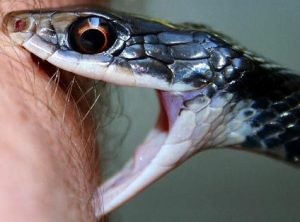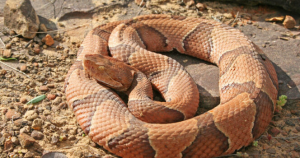Don’t panic and try to suck the venom out when you think of a snake bite. If a snake bites you, following these steps right after can be a real lifesaver, even for you.
Snakes are not all venomous and fatal cases from snake bites are rare in the U.S. Even so, untreated bites can seriously hurt or even take a person’s life. Therefore, let’s examine the parts of this topic.

Venomous snakes
Mayo Clinic states that about 20% of snakes in the U.S. are venomous, while only 15% of the many species worldwide are considered venomous.
Snakes that are venomous in North America are:
Rattlesnakes
Copperheads
Cottonmouths
Coral Snakes
Most venomous snakes in America are pit vipers which stand out because of their triangular heads, slit-shaped pupils, pits that sense heat between the eyes and nostrils and their fangs. The coral snake stands out because it has round eyes, a bulbous and cigar-like head and red, yellow and black stripes.

Symptoms after a snake bite
Many of these snake bites happen on the upper body – to the arms, wrists or hands – since people often get too near or don’t see the snake until it’s too late.
To be bit by a snake that might not be venomous
Encountering a nonvenomous snake is something to be happy about. They might be annoying, but usually these criticisms are more talk than action. Noticing localized pain, some damage or marks and possibly a little swelling or reddening at the location is normal. It operates much like a natural sign of danger.

If you are bitten by a venomous snake
However, when a venomous snake bites you, things progress very fast. The pain starts suddenly and is very severe at the bite before it gets worse. Usually, the swelling and bruising start after that and they can be found in areas close to the bite according to the Mayo Clinic. Nausea, trouble breathing, weakness and a sudden metallic taste in your mouth are possible reactions to heart ailments.
Certain snakes such as the coral snake, produce venom that is not the same as other snakes. Their toxins are not meant for tissues, but they affect the nervous system, so you might have droopy eyelids, tingling of the fingers or toes, problems with swallowing and a loss of muscle strength. These symptoms are much more serious than odd and they require immediate attention.
Dry bite
Also, sometimes a snake bites but doesn’t inject any venom into the wound which is known as a dry bite.
Being able to tell the types of bites apart and spotting early signs could significantly improve care.
“Generally, someone dies from a venomous snake bite because they are not healthy, are allergic to the snake or get treatment too late,” warns the American Red Cross.
What you should do if you are bitten by a snake
1. Try to relax: While this is often hard, remaining calm can lower your heart rate which may hamper the transmission of venom.
2. Dial 911 or get to an emergency room as fast and safely as you can. Quick medical attention saves the lives of many people.
3. Maintain the location of the bite by not moving it farther from your heart, since movement can let venom reach blood faster. Varying on the circumstances, put a splint or sling on the affected limb to help immobilize it and keep it beneath heart level.
4. Discard or remove clothing and jewelry you wear in case of fast swelling. Remove rings, watches or snug-fitting clothing from the area around the bite to avoid problems with blood flow.
5. Try to see what kind of snake it is: If you can, take a picture or remember what the snake looks like. Doctors can pick the proper antivenom with this understanding.
Things people shouldn’t do
Learning what actions to avoid after a snake bite is as important as learning what actions to take.
Do not:
Attempt to suck the venom out – But this is only in the movies, not in real life.
If there is a laceration, don’t cut it – you might worsen the injury.
Apply ice or a tourniquet – Both may cause extra damage to the tissues.
Tackle the snake – Do not be heroic and try to round up the snake.
Following the right guidance after a snake bite often leads to a successful recovery. Snakes are generally not looking for trouble or trying to hurt you. Few reptiles enjoy being confrontative; most would usually rather escape situations. If a bite does happen, you now have the steps to follow.
